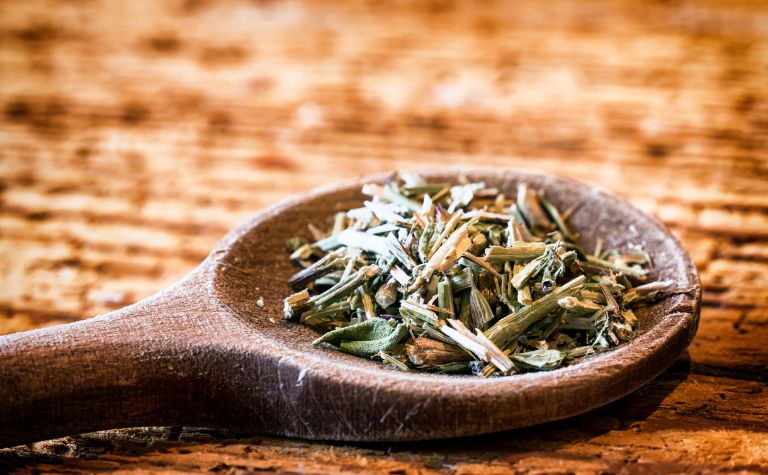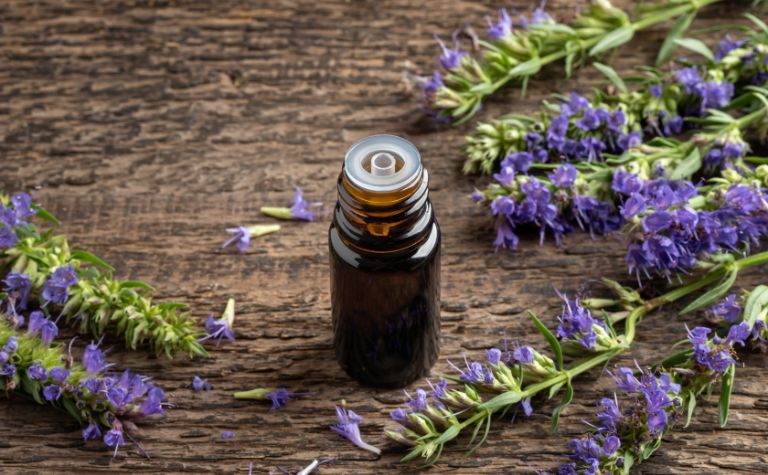Students of the Bible find references to hyssop from Exodus in the Old Testament to the Gospel of John in the New Testament. It plays a part in important stories like Israel’s exodus from Egypt and Jesus’ crucifixion. Yet some Bible readers aren’t sure exactly what it is.
Hyssop is a plant whose stalks grow to about two feet high. Some scholars identify it with herbs like mint or sage. The Bible mentions the plant in several verses. The most well-known reference is when soldiers use a hyssop stalk to lift a wine-soaked sponge to Jesus during his crucifixion.
When do soldiers use a hyssop branch to give Jesus wine? Did he taste it? What did Jesus say before and after it? How did soldiers use thin stalks to lift a soaked sponge? What do hyssop plants have to do with the tenth plague? Why do other books, like Psalms, mention hyssop plants? Keep reading to learn the answers to these questions and others.
Also, see What is a Cubit in the Bible? to learn more.

Soldiers Offer Jesus Wine Using a Hyssop Branch
There is only one reference to hyssop in the Gospels. According to John, soldiers offered Jesus wine on a hyssop branch when he was dying on the cross for the sins of the world (John 3:16), in between his well-known statements, “I thirst” (John 19:28) and “it is finished” (John 19:30).
John writes, “A jar full of sour wine stood there, so they put a sponge full of the sour wine on a hyssop branch and held it to his mouth” (John 19:29, ESV). Jesus tasted the wine on the sponge, then died (John 19:30).
| Greek | ὕσσωπος |
| Transliteration | hussopos |
| Part of speech | noun |
| Translation | hyssop |
| Definition | hyssop, a stalk or stem of hyssop |
Some wonder how soldiers could use the stalk of a hyssop plant to lift a sponge to Jesus due to its short length and relative weakness. John commentator Gary Burge explains, “This is possible because the cross was not elevated in the air, but low, no higher than the height of one of the soldiers. The flexible branches of the shrub would barely work for this effort, but a center stalk would.” [1]
Also, see What is a Sodomy in the Bible? to learn more.

What Was Hyssop Important in the Old Testament?
People used hyssop stalks and the flowers like bristles on a brush. They would dip the ends of a group of stalks in a liquid and then paint it on something, using the plants and pedals to sweep and smear it.
The Holman Illustrated Bible Dictionary explains the practical use of a hyssop branch: “Stalks of hyssop bear numerous, small, white flowers in bunches. Hyssop was thus well suited for use as a ‘brush’ to dab the lintels of Israelite homes with the blood of the Passover lambs (Exod. 12:22).” [2]
Before the exodus, in preparation for the tenth plague, the death of the firstborn son, Moses told the Israelites to “take a bunch of hyssop and dip it in the blood that is in the basin, and touch the lintel and the two doorposts with the blood that is in the basin. None of you shall go out of the door of his house until the morning” (Exod. 12:22, ESV).
The use of the hyssop branch in the story of Passover leaves some Bible scholars to believe that John intends to express that Jesus is God’s Passover lamb.
New Testament historian Craig Keener writes, “John may envision the stalk of a plant that he calls ‘hyssop’ to draw a parallel with the Passover ritual, in which hyssop played a prominent role (Exod. 12:22); John elsewhere portrays Jesus’ death as a new Passover (18:28; 19:36; 1 Cor. 5:7; 1 Pet. 1:19).” [3]
Also, see What is Discipleship in the Bible? to learn more.

Bible Verses That Mention Hyssop
The references to hyssop in Leviticus and Numbers describe it as a tool to dip in blood and sprinkle. 1 Kings mentions it as a plant. Psalms, likely using hyssop symbolically, describes it as cleansing from sin (cf. 1 John 1:9). The book of Hebrews refers to hyssop when it mentions Moses’ consecration of the Law.
Leviticus 14:4, “The priest shall command them to take for him who is to be cleansed two live clean birds and cedarwood and scarlet yarn and hyssop.”
Leviticus 14:6, “He shall take the live bird with the cedarwood and the scarlet yarn and the hyssop, and dip them and the live bird in the blood of the bird that was killed over the fresh water.”
Leviticus 14:49, “And for the cleansing of the house he shall take two small birds, with cedarwood and scarlet yarn and hyssop.”
Leviticus 14:51, “And shall take the cedarwood and the hyssop and the scarlet yarn, along with the live bird, and dip them in the blood of the bird that was killed and in the fresh water and sprinkle the house seven times.”
Leviticus 14:52, “Thus he shall cleanse the house with the blood of the bird and with the fresh water and with the live bird and with the cedarwood and hyssop and scarlet yarn.”
Numbers 19:6, “And the priest shall take cedarwood and hyssop and scarlet yarn, and throw them into the fire burning the heifer.”
Numbers 19:18, “Then a clean person shall take hyssop and dip it in the water and sprinkle it on the tent and on all the furnishings and on the persons who were there and on whoever touched the bone, or the slain or the dead or the grave.”
1 Kings 14:33, “He spoke of trees, from the cedar that is in Lebanon to the hyssop that grows out of the wall. He spoke also of beasts, and of birds, and of reptiles, and of fish.”
Psalms 51:7, “Purge me with hyssop, and I shall be clean; wash me, and I shall be whiter than snow.”
Hebrews 9:19, “For when every commandment of the law had been declared by Moses to all the people, he took the blood of calves and goats, with water and scarlet wool and hyssop, and sprinkled both the book itself and all the people.”
Also, see What is Circumcision in the Bible? to learn more.
References:
[1] John by Gary Burge. NIVAC. p. 529.
[2] Holman Illustrated Bible Dictionary. p. 784.
[3] The Gospel of John: A Commentary (Vol. 2) by Craig Keener. p. 1147.
Related Questions
Regular Bible reading is a valuable habit, as Scripture is God's message to people. However, the Bible's 66 distinct books, featuring various authors, settings, and themes, can make it challenging...
Catholic vs. Protestant vs. Orthodox: What's the Difference?
Roman Catholicism, Protestant Christianity, and the Eastern Orthodox Church are the three historical branches of the Christian religion. Each tradition traces its doctrines and practices to the New...
